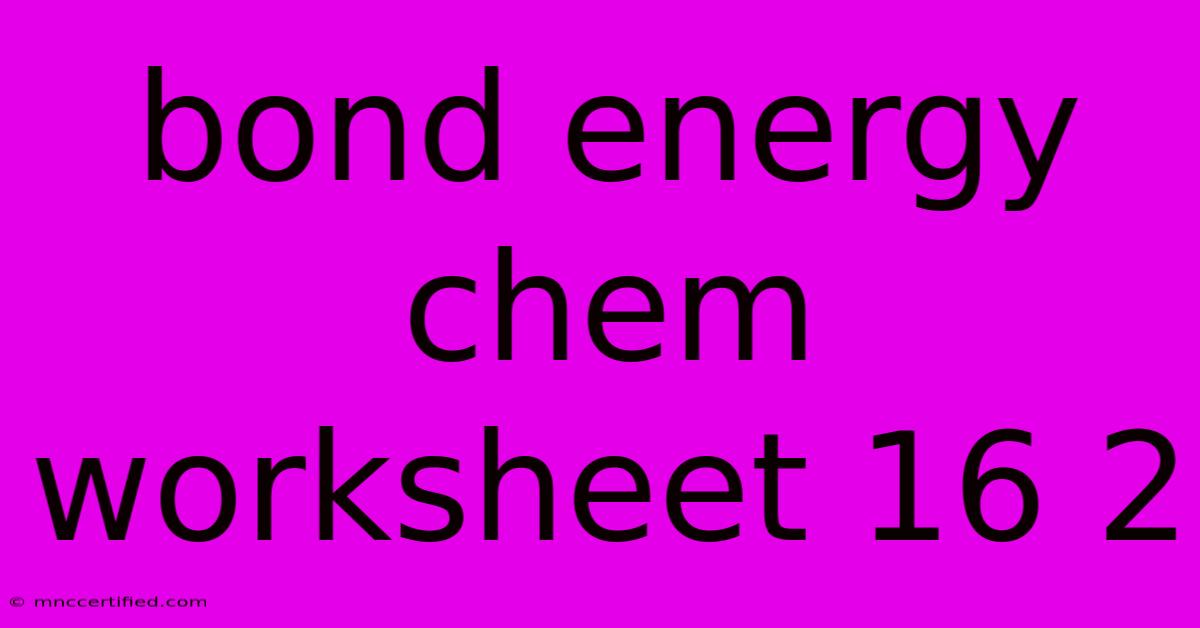Bond Energy Chem Worksheet 16 2

Table of Contents
Bond Energy: Chem Worksheet 16.2 – A Comprehensive Guide
This article serves as a comprehensive guide to understanding and mastering bond energy calculations, specifically addressing the concepts typically covered in Chemistry Worksheet 16.2. We'll break down the fundamental principles, provide practical examples, and offer tips to excel in this area of chemistry.
Understanding Bond Energy
Bond energy, also known as bond dissociation energy, refers to the amount of energy required to break one mole of a specific type of bond in the gaseous phase. It's a crucial concept in thermochemistry, helping us understand and predict the energy changes involved in chemical reactions. A higher bond energy indicates a stronger bond, requiring more energy to break.
Key Concepts:
- Exothermic vs. Endothermic Reactions: Bond breaking is always endothermic (absorbs energy), while bond formation is exothermic (releases energy). The overall energy change in a reaction depends on the balance between the energy required to break bonds in reactants and the energy released when new bonds form in products.
- Hess's Law: This law states that the total enthalpy change for a reaction is independent of the pathway taken. We can use Hess's Law, along with known bond energies, to calculate the enthalpy change (ΔH) for a reaction.
- Average Bond Energies: Since bond energy can vary slightly depending on the molecule's structure and surrounding atoms, we often use average bond energies obtained from a large number of experimental measurements. These average values are readily available in most chemistry textbooks and data tables.
Applying Bond Energy Calculations: Examples from Chem Worksheet 16.2
Let's illustrate the application of bond energy calculations with a typical problem from Chem Worksheet 16.2. These problems often involve calculating the enthalpy change (ΔH) of a reaction using bond energies.
Example Problem: Calculate the enthalpy change (ΔH) for the reaction: CH₄(g) + 2O₂(g) → CO₂(g) + 2H₂O(g) using the following average bond energies (kJ/mol): C-H = 413, O=O = 498, C=O = 799, O-H = 463.
Solution:
-
Identify bonds broken: In the reactants, we break 4 C-H bonds and 2 O=O bonds.
-
Identify bonds formed: In the products, we form 2 C=O bonds and 4 O-H bonds.
-
Calculate the total energy change:
- Energy to break bonds: (4 × 413 kJ/mol) + (2 × 498 kJ/mol) = 2652 kJ/mol
- Energy released from bond formation: (2 × 799 kJ/mol) + (4 × 463 kJ/mol) = 3122 kJ/mol
- ΔH = Energy to break bonds - Energy released from bond formation = 2652 kJ/mol - 3122 kJ/mol = -470 kJ/mol
The negative sign indicates that the reaction is exothermic, releasing 470 kJ of energy per mole of methane reacted.
Tips for Mastering Chem Worksheet 16.2
- Understand the concepts: A solid understanding of bond energy, enthalpy, and Hess's Law is paramount.
- Practice consistently: Work through numerous problems, including those similar to the ones in your worksheet.
- Use a reliable data table: Ensure you're using consistent and accurate average bond energy values.
- Pay attention to units: Always check your units throughout the calculations to avoid errors.
- Seek help when needed: Don't hesitate to ask your teacher or tutor for assistance if you're struggling.
Off-Page SEO Considerations
To enhance the search engine optimization (SEO) of this article, consider the following off-page strategies:
- Building high-quality backlinks: Share this article on relevant online forums, social media platforms, and educational websites.
- Guest blogging: Contribute articles about chemistry and bond energy to other educational blogs.
- Engage with other content: Participate in relevant discussions and comment sections online.
By mastering the concepts explained in this guide and employing both on-page and off-page SEO strategies, you'll be well-equipped to tackle Chem Worksheet 16.2 and excel in your chemistry studies. Remember, consistent practice and a clear understanding of the fundamentals are key to success.

Thank you for visiting our website wich cover about Bond Energy Chem Worksheet 16 2. We hope the information provided has been useful to you. Feel free to contact us if you have any questions or need further assistance. See you next time and dont miss to bookmark.
Featured Posts
-
Wicked Opens Fans Ecstatic Blockbuster Hit
Nov 23, 2024
-
Anna Samson On Paradise Audience Response
Nov 23, 2024
-
Bond Place Hotel Toronto Canada
Nov 23, 2024
-
Joao Pereira In Portuguese Cup
Nov 23, 2024
-
Mc Gregor Rape Lawsuit Verdict In
Nov 23, 2024